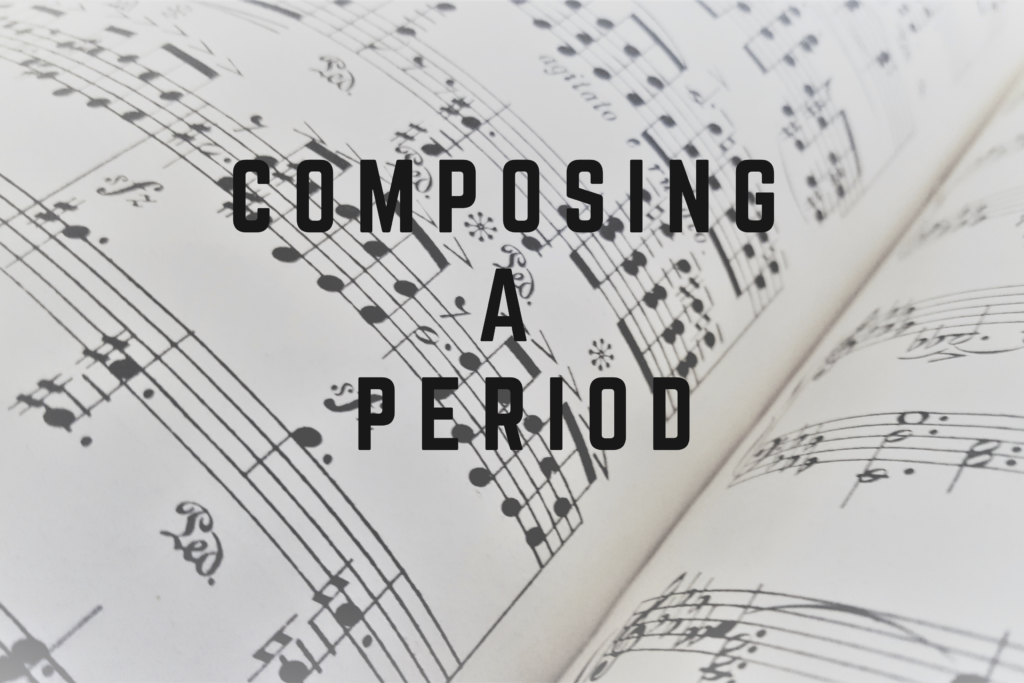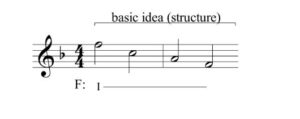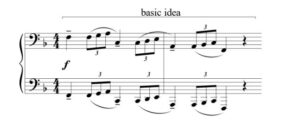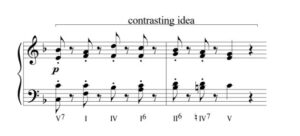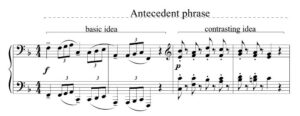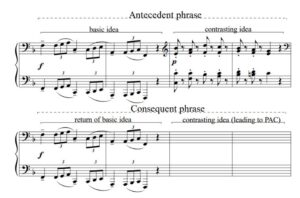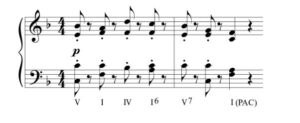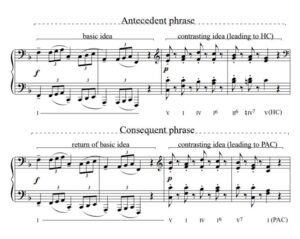Music Theory Resoucers
Composing a Period
Composing a period: Welcome to a new article belonging to the series on William Caplin´s formal theory!
This article explains, step by step, how to compose a musical period following the custom and stylistic guidelines of the common practice period.
The first thing we must do when composing a piece of music is define the time and key signatures. For this piece, we will select a time signature of 4/4, which occurs very frequently in the classical style, and the key signature will be F major. We already know that the structure of the simple period consists of 8 measures, which are made up of two phrases: a 4-m antecedent phrase, and a 4-m consequent phrase.
The antecedent phrase begins with a 2-m. basic idea, followed by a 2-m. contrasting idea.
The consequent phrase brings a return of the basic idea, followed by a contrasting idea (which may or may not resemble the one in the antecedent) and leads to a stronger cadence.
If you want to understand the period structure in more detail, click on the link below for our post analyzing The Period:
https://www.piano-composer-teacher-london.co.uk/post/the-period-main-themes-sonata-analysis
So far, our scheme for composing a period would look like this:
Now we must begin to compose the basic idea. In order to establish the tonic clearly, we will perform a prolongation of the tonic triad in the first two bars of the piece. The scheme is illustrated below:
Once we have the structure of the basic idea, we must add superficial details to “hide” the structure and thus obtain greater musical richness.
Here is one of many possible realisations:
Now that we have the musical surface for the basic idea, we need to think of some material for the left hand.
We must take into account that the three basic types of texture in the music of the common practice period are the following:
Monophonic texture: single-line melody with no accompanying parts.
Homophonic texture: music with more than one voice or part. We tend to direct our attention to a single prominent melodic line and relegate the other parts to a secondary status.
Contrapuntal texture: consists of the simultaneous combination of melodic lines. Each voice retains its own melodic contour and rhythmic identity.
In the basic idea, we will opt for a monophonic texture.
Note that in the example below, we have placed the melody in a low register in order to give more identity to the basic idea.
The next step is to compose a contrasting idea.
The best way to compose a truly contrasting material, is to analyse the behaviour of each of the musical parameters of the basic idea.
Analysis of musical parameters in the basic idea:
- Register: low
- Articulation: tenuto and legato
- Dynamics: forte
- Texture: monophonic
- Harmonic rhythm: There is no movement in terms of harmony
For the contrasting idea, we will use the opposite of each parameter.
Musical parameters in the contrasting idea:
- Register: high
- Articulation: staccato
- Dynamics: piano
- Texture: homophonic
- Harmonic rhythm: a new chord is introduced on each beat
We have already finished composing the antecedent phrase of our period. The graph is shown below:
Now we must compose the consequent phrase, which brings a return of the original basic idea and then is followed by a contrasting idea, leading us to a stronger cadence.
In the pieces of the classical period, it is not difficult to find examples where the basic idea of measures 5 and 6 does not present any variation with respect to that presented in measures 1 and 2. Therefore, for the composition of this piece, we will not introduce any modification on the return of the basic idea.
Below is the score that includes the first six bars of the piece:
Finally, we must compose a contrasting idea in measures 7 and 8.
We have two options as to how similar the material in measures 7 and 8 is to the material used previously. Namely:
- That the texture is the same (or similar) to that used in measures 3 and 4.
- That the texture is different from the one used in bars 3 and 4. That is, a new contrasting idea with new melodic, rhythmic, or textural material.
In this case, in order to provide a greater sense of unity to the piece, we will use the same texture that appears in the contrasting idea of the antecedent phrase.
It is important to note that we need to change the ending, since our goal is to end the period with a PAC.
Below is the sheet music for measures 7 and 8:
We have finished composing the period. Below is an audio of the piece, plus the score with detailed analysis.

